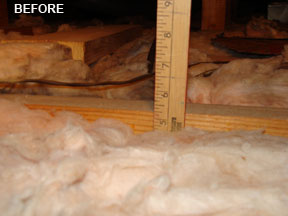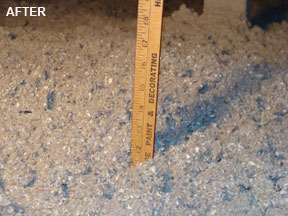In the southeast many mountains in WV and other beautiful places are sacrificed to generate cheap electricity for millions of people. The results are ecologically devastating to the local ecosystems and the burning coal releases millions of tons of CO2 into atmosphere contributing to global warming and air pollution. Until enough renewable and clean energy sources are put in place - the best way to reduce the negative effects of coal-fired electricity is to reduce the amount of energy we consume.
On that note our company began an initiative to see how much we can cut our electric use. I'll explain what we've done and give you the initial results. As more data (aka electric bills) comes in I'll keep you updated on our ongoing progress. My personal goal is to achieve a 50% reduction.
When we first moved into this location - electric baseboard was the only form of heating. Those first bills were enormous (well over $200/month in the winter). We quickly discovered that electric baseboard heating was one of the most inefficient forms of heating. In quick order we added some propane heaters to the mix and reduced our heating costs greatly early on. When our central air conditioner died the next summer, we opted for a high efficiently heat pump/AC - a good move! Now we only use a few gallons of propane each year to help out on the coldest days or when there are power outages.
We replaced all the windows with double pane vinyl windows - which are a huge improvement over the original uber-drafty ones.
OK. Keep in mind that all of the above was implemented before we started our new greening initiative, so the results will only show the changes we've made recently (since Feb 2008). Here's what we've done since then:
 We have installed Compact Florescent Lightbulbs (CFLs) into most of the fixtures in our
office and home. We've been putting them
into the most used fixtures first and will gradually eliminate all standard
incandescent bulbs.
We have installed Compact Florescent Lightbulbs (CFLs) into most of the fixtures in our
office and home. We've been putting them
into the most used fixtures first and will gradually eliminate all standard
incandescent bulbs.
We also installed a water heater blanket insulator to help
save on that energy cost - these run under $20 and are something anyone can
install. Heating hot water uses a lot more energy than most realize and making that process more efficient is wise.
We installed an attic fan to vent hot air in the summer - reducing cooling costs and increasing roof life.
We added power strips to computers, entertainment centers and other areas so that phantom power loads are eliminated when not in use by switching off the power strips. We now shut down all of the computers each evening after we're done working and the files have backed up.
We installed a programmable thermostat allowing the air conditioning to turn down automatically when not needed.

 We blew in approximately 1200lbs of recycled cellulose fiber insulation into attic increasing the insulation depth from about 5 inches to about 12 inches. If you find that your attic is lacking adequate
insulation you can do this too. My wife
& I completed it on a Saturday. Your local Home Depot or Lowes will rent
you the blower for free if you purchase a certain amount of insulation (we used
about 2x as much as required for the free rental).
We blew in approximately 1200lbs of recycled cellulose fiber insulation into attic increasing the insulation depth from about 5 inches to about 12 inches. If you find that your attic is lacking adequate
insulation you can do this too. My wife
& I completed it on a Saturday. Your local Home Depot or Lowes will rent
you the blower for free if you purchase a certain amount of insulation (we used
about 2x as much as required for the free rental).
In addition to the projects above we also educated our employees on ways to conserve (like turning off monitors, lights, printers, stereo etc when not in use). Sherry, Trevor & I attended a Renewable Energy Class offered by our local community college. This course taught us many of the principals we're now putting into motion. There's also a plethora of great books on the subject. One that I recommend that covers many subjects is the Solar Living Sourcebook from www.realgoods.com .
RESULTS!
March 2008- bill shows we reduced our AVG KWH/day from 54 in 2007 to 42 in 2008 that's a 22% decrease!
April 2008 - 48 KWH/day to 33 a 31% decrease!
May 2008 - 42 KWh/day to 23 a 45% decrease!!!
June 2008 - 54 KWH/day to 42 a 22 % decrease! Multiple triple digit record high temps this month cut into savings percentage.
July 2008 - 62 KWH/day to 39 a 37% decrease!
In July we installed solar collectors to heat our hot water and replaced our old 1992 refridgerator with a new Energy Star model.
August 2008 - 67 KWH/day to 32 a 52% decrease! Goal achieved!
Ocotber 2008 - 45 KWH/day to 23 a 49% decrease.
We hope you'll learn from our examples and decrease your carbon footprint as well!

